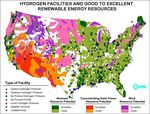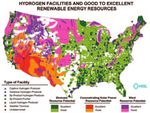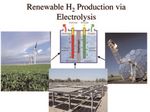Renewable Hydrogen Forum - American Solar Energy Society
←
→
Page content transcription
If your browser does not render page correctly, please read the page content below
Renewable
Hydrogen
Forum
A Summary of Expert Opinion
and Policy Recommendations
National Press Club
Washington, DC
October 1, 2003
Forum Presented By:
American Solar Energy Society
Hosted at World Resources Institute
Prepared by
Paulette Middleton,
Ron Larson,
Mike Nicklas
and Brad CollinsThe Cost of Renewable Energy
Levelized cents/kWh in constant $2000
Cathode Anode
Hydrogen Oxygen
Diaphragm
Hydrogen Oxygen
Bubbles Bubbles
Electrolytic Solution
Photo Credits
Cover (from the top): NREL PIX 04745, the wood gasification
unit at the McNeil Generating Station of the Burlington, Vermont
Electric Department; NREL PIX 05377, Scientific Application International
Corporation’s heliostat system for central receivers; NREL PIX 02184,
Solar Two heliostats of the Southern California Edison Plant in Dagett,
California (courtesy of Joe Flores); NREL PIX 08846, Parabolic trough
collection filed near Phoenix, Arizona; NREL PIX 01242, a wind turbine
farm located in Palm Springs, California.
Inside Front Cover: The Cost of Renewable Energy
charts developed by the NREL Energy Analysis Office.
Inside Back Cover (from the top): Renewable H2
Production via Electrolysis diagram courtesy of Margaret Mann,
NREL; Hydrogen Facilities and Good to Excellent Renewable
Energy Resources map developed by the Resource Assessment
Group at NREL.
Back Cover (from the top): NREL PIX 05559, The Leathers
geothermal power plant in Imperial county, California; NREL PIX
10805, photovoltaic array located on the canopy of the BP gas
station in Fairfield, California (courtesy of BP Solar); NREL PIX 01007,
Fast-pyrolysis from non-food feedstocks in the process development
tank at NREL; NREL PIX 03978, the Praxair, Inc., hydrogen production
facility in Niagra Falls, New York (courtesy of Praxair, Inc.); NREL PIX
03034, photovoltaic used to help power fueling facilities for hydrogen-
powered buses at the SunLine transit Agency in Thousand Palms,
California (courtesy of Leslie Eudy); NREL PIX 04242,parabolic trough
collectors used to heat water at the Jefferson County Jail, Golden,
Source: NREL Energy Analysis Office Colorado.
These graphs are reflections of historical cost
trends NOT precise annual historical data.
Updated: October 2002RENEWABLE HYDROGEN FORUM
A Summary of Expert Opinion and Policy Recommendations
National Press Club
Washington, DC
October 1, 2003
Forum Presented By:
American Solar Energy Society
In Cooperation with:
American Hydrogen Association
American Lung Association
American Wind Energy Association
Environmental and Energy Study Institute
Hydrogen Now!
National Hydrogen Association
Solar Energy Industries Association
The Wirth Chair in Environmental and Community Development Policy
World Resources Institute
Worldwatch Institute
Hosted at World Resources Institute
Prepared by
Paulette Middleton, Ron Larson, Mike Nicklas and Brad CollinsRenewable Hydrogen Forum
The Renewable Hydrogen Forum brought together many of the top scientists,
researchers, business leaders and economists involved in hydrogen and renewable
energy to more clearly define the:
Current and projected potential for renewable hydrogen
Benefits to society if our hydrogen future was fueled primarily by renewable
energy
Research and development efforts needed to maximize the potential of
renewable energy
The complicated nature of the issues as well as the variety of ideas presented led
to a wide range of perspectives. Although, there were debates over technologies
and economics of different systems, there was no disagreement that clean
hydrogen must be produced from clean energy and that renewable technologies
are already offering more than just promise for the long term.
This document is dedicated to honoring the perspectives of the Forum.
ASES – September 1, 2003 -- Boulder, Colorado
Acknowledgment
The American Solar Energy Society wishes to thank and acknowledge its Renewable
Hydrogen Forum partners:
American Hydrogen Association, American Lung Association, American Wind
Energy Association, Environmental and Energy Study Institute, Hydrogen
NOW!, National Hydrogen Association, Solar Energy Industries Association,
the Wirth Chair in Environmental and Community Development Policy, World
Resources Institute, Worldwatch Institute.
The Renewable Hydrogen Forum was made possible in part by the financial support
from:
• The Holliday Family
• The Leighty Foundation
• Anonymous
Finally, the American Solar Energy Society wishes to acknowledge and thank the
Forum participants for their voluntary participation in this event and passion for
renewable hydrogen.TABLE OF CONTENTS
INTRODUCTION............................................................................................................. 1
FORUM PRESENTATION HIGHLIGHTS ....................................................................... 2
WELCOME.................................................................................................................. 2
Mike Nicklas – Chair, ASES ................................................................................. 2
Jonathan Lash – President, World Resources Institute ........................................ 3
CURRENT & NEAR-TERM POTENTIAL .................................................................... 3
The Supply Technologies......................................................................................... 3
Introduction to Issues – Yogi Goswami ................................................................ 4
PV/Electrolysis – Larry Kazmerski........................................................................ 7
Wind and PV/Electrolysis – Paul Scott ............................................................... 10
Biomass/Pyrolysis – Danny Day......................................................................... 12
Concentrating Solar Power (CSP)/Electrolysis – Gilbert Cohen ......................... 12
Biomass – Ralph Overend.................................................................................. 13
The Delivery System .............................................................................................. 14
Introduction to Issues – Jeffery Serfass.............................................................. 15
Vehicles – David Friedman................................................................................. 15
Centralized Wind – Bill Leighty ........................................................................... 15
Decentralized Technologies – Martin Shimko..................................................... 18
Decentralized Technologies – Jonathan Hurwitch.............................................. 18
Panel Discussion.................................................................................................... 19
FUTURE .................................................................................................................... 21
Future of Renewable Hydrogen ............................................................................. 21
Introduction to Issues & Moderator – Susan Hock.............................................. 22
Chemical – Aldo Steinfeld .................................................................................. 25
CSP/Electrolysis and Thermal – Dale Rogers .................................................... 28
Algae – Ralph Overend ...................................................................................... 28
Future Research Needs ......................................................................................... 29
David Garman .................................................................................................... 29
Stan Bull ............................................................................................................. 30
KEYNOTE ADDRESS.............................................................................................. 33
Building the Wind/Hydrogen Economy – Lester Brown.......................................... 33
Discussion.............................................................................................................. 37
ECONOMICS ............................................................................................................ 39
Introduction to Issues & Moderator – Harry Braun.............................................. 39
Henry Kelly ......................................................................................................... 40
Margaret Mann ................................................................................................... 41
Sivan Kartha ....................................................................................................... 47
Economics Panel Discussion and Questions ..................................................... 50
HEALTH AND ENVIRONMENTAL CONSEQUENCES OF NON-RENEWABLE
HYDROGEN .............................................................................................................. 52
Introduction to Issues & Moderator – Roy McAlister........................................... 52
Health Impacts – Anthony DeLucia .................................................................... 54FORUM SUMMARY ..................................................................................................... 57
MOVING FORWARD: THE RECOMMENDED STEPS............................................. 60
REFERENCE INFORMATION...................................................................................... 62
ACRONYMS.............................................................................................................. 62
BIOGRAPHICAL & CONTACT INFORMATION....................................................... 62
Presenters & Forum Report Authors ...................................................................... 62
Other Quoted Contributors, Reviewers & Organizers ............................................ 71
APPENDIX A: Forum Press Conference Remarks ................................................ 72
Mike Nicklas – Chair, American Solar Energy Society ....................................... 72
Lester Brown – President, Earth Policy Institute................................................. 73
Yogi Goswami – Vice President, International Solar Energy Society; Senior Vice
President, American Society of Mechanical Engineers ...................................... 73
APPENDIX B: Numerical Data from Presenters .................................................... 74
Ron Larson, Chair Renewable Hydrogen Forum; Board of Directors, American
Solar Energy Society .......................................................................................... 74
ENDNOTES............................................................................................................... 79INTRODUCTION
On April 10 and 11, 2003, the American Solar Energy Society (ASES) and its partners
conducted a roundtable that addressed one of the most critical energy and
environmental challenges the world faces—determining the energy path to producing
hydrogen. The Forum focused on the importance and promise of hydrogen produced
from renewable energy---renewable hydrogen.
ASES, along with many other renewable, environmental, and health organizations, has
been promoting a renewably derived hydrogen economy--a more environmentally
sound, economically stable, healthier future fueled by renewable energy. Today,
awareness of the need to pursue this goal is greater than ever. Continually increasing
oil and gas imports are hurting the U.S. economy. The effects of global warming are
becoming pervasive. Health problems associated with fossil fuel use are impacting
millions throughout the country. Oil availability and nuclear plant safety are now both
critical national security problems.
As the country’s needs and interest in moving toward a hydrogen future increase, efforts
to understand and evaluate the options must also increase. Which path or paths will
result in the most sustainable, long-term solution? Today, the fossil and nuclear
industries believe that they are best suited to fuel the new hydrogen economy. Many in
the health, environmental, and renewable energy fields believe otherwise.
Forum Report Organization
This report is organized as follows:
Forum Presentations: The presentations and panel remarks are summarized around
the common themes of the session, as follows:
Current and Near-Term Potential for Renewable Hydrogen
Future of Renewable Hydrogen
Future Research Needs
Economics of Renewable Hydrogen
Health and Environmental Consequences of Non-Renewable Hydrogen
Highlights are given for each presentation in this report. The full power point
presentations and other related materials are posted on the ASES website:
http://www.ases.org/
Forum Summary: The summary provided at the end of this report outlines many of the
main points presented at the forum and provides references to most participants who
discussed these topics.
1FORUM PRESENTATION HIGHLIGHTS
WELCOME
The Forum was welcomed on Thursday, April 10. Mike Nicklas, American Solar Energy
Society (ASES) Chair, provided an overview of the Forum history and objectives.
Jonathan Lash, President, World Resources Institute, discussed the World Resources
Institute mission in relationship to the Forum. Ron Larson, Forum Chair and Member of
Board of Directors, ASES, provided guidance for the Forum process and introduced the
participants.
Mike Nicklas – Chair, ASES
The American Solar Energy Society was created in 1954. Through our various
chapters we have about 10,000 members in the United States. We have always
focused on solar energy in a very broad sense. We embrace the whole gamut of
technologies that are directly or indirectly derived from solar energy— from wind to
biofuels. A few of our technologies have actually been used in the production of
hydrogen and most of the key players are in this room today.
Although the benefits of the hydrogen
economy are still years away, our
biggest challenges from a
sustainability standpoint are here
today. The decisions that we make, as a
country, the research that we choose to
support and the demonstration projects
that we fund now, will no doubt determine
our hydrogen future and whether
ultimately we will be fueled by either
environmentally sound renewable options
or non-sustainable approaches. ASES’
goal has been to join with as many Anthony DeLucia, Maury Albertson
organizations as we can and to bring
focus to these issues. I think it’s a very timely issue for us. Our collective efforts will
determine our success. Thank you all for joining in this most important step.
2Jonathan Lash – President, World
Resources Institute
It used to be that if you mentioned
hydrogen the reaction you got was, “It’s
theoretically possible but it’s not part of our
lives.“ Now the question I get is, “Where
are you going to get the hydrogen?” This
is a huge step forward. The issues
discussed at this Forum are the key issues
in this debate. The role for the people at the
cutting edge becomes an important one—to
define the best possible transition to the
hydrogen economy. Renewable Hydrogen Forum
CURRENT & NEAR-TERM POTENTIAL
This session focused on hydrogen generation and supply technologies that are currently
available or have near-term potential. Presentations on both renewable generation and
delivery were presented and then followed by a panel discussion on both aspects.
The Supply Technologies
The session reviewed key near term renewable energy supply technologies in six
presentations:
Introduction to Issues & Moderator: Yogi Goswami, Vice President, International
Solar Energy Society; Senior Vice President, American Society of Mechanical
Engineers
Photovoltaic/Electrolysis: Larry Kazmerski, Director, National Center for
Photovoltaics, National Renewable Energy Laboratory
Wind & PV/Electrolysis: Paul Scott, President, Stuart Energy USA
Biomass/Pyrolysis: Danny Day, President, Eprida
Concentrating Solar Power/Electrolysis: Gilbert Cohen, Vice President of
Engineering & Operations, Solargenix Energy (formerly Duke Solar)
Biomass: Ralph Overend, Research Fellow, National Renewable Energy
Laboratory
Each of the presenters discussed various aspects of cost, resource flexibility, and
availability of the technologies. The human health and environmental benefits of using
3renewable energy and energy security also were discussed as major drivers for
renewable hydrogen.
Introduction to Issues – Yogi Goswami
Hydrogen can provide a solution to the intermittency of solar energy or indirect solar
energy, like wind, biomass and so on. We hear people talking about hydrogen as the
clean energy source, but hydrogen is not an energy source. Hydrogen is clean only if
it’s produced from clean sources. It’s dirty if it’s produced from dirty sources.
So, whether you use water, biomass, hydrocarbons, or coal to produce hydrogen
becomes an extremely important decision. The overall hydrogen systems are
summarized in Figure 1.
Hydrogen
Production Plants
Liquid H2 Gaseous H2
Jet Engines Flame combustors
IC Engines Catalytic Combustors Fuel Cells
Fuel Cells H2/O2 steam generators
Transportation Thermal Energy Electric Power
* Sherif, S., T. Veriziglo, and F. Barbir, 1999, “Hydrogen Energy Systems,” pp. 370-402, Wiley Encyclopedia of Electrical and
Electronics Engineering, vol. 9, J. G. Webster, (Editor), John Wiley & Sons, New York.
Figure 1. Hydrogen Systems
The key hydrogen energy issues that we need to consider are:
Production
o Feed Stock
o Energy Resource
o Local vs. Remote Production
o Environmental Impact
Storage, Transportation and Handling
o Gaseous, Liquid, Solid Storage
o Transportation via Pipelines, Rail, Trucks
Safety Issues in Production Storage and Transportation
o Safety Codes and Standards
4Hydrogen Production
There are a number of ways you can produce hydrogen, as outlined in Table 1.
Between 55%-60% of the
hydrogen being produced in the Table 1. Hydrogen Production Technologies
world today is produced by steam Steam reformation (SMR) Photochemical
reformation. Hydrogen is also Thermal cracking Photo-electrochemical
produced via water electrolysis Partial oxidation (POX) Thermochemical
using electricity from the grid. Coal Coal gasification (CG) Solar Thermal
and nuclear are possibilities as are Biomass gasification (BG)
Nuclear
solar technologies, including solar Electrolysis
Biological production
Grid (Coal, Nuclear)
photovoltaic, and solar thermal Solar Photovoltaic
Thermal Decomposition
power. Wind is also an option. Solar Thermal Power
Advanced technologies like Wind
photochemical, photoelectric
chemical, thermal chemical, and
thermal chemical—the high temperature processes where solar thermal seems like an
ideal resource—are also under development.
Steam methane reformation (SMR) takes a light hydrocarbon feedstock, usually
methane, then reacts it with it elevated temperature steam and catalytically converts the
feedstock into hydrogen. It operates at around 700°-925° C and can achieve 65%-75%
efficiency. Based on an analysis for NASA completed last year, the cost for hydrogen
from SMR, without adding any environmental cost on polluting fuels, was estimated at
$6 per gigajoule. Due to rising natural gas costs today, the estimated cost has
increased to $10 per gigajoule. There are two problems with the SMR process: carbon
dioxide (CO2) production and the volatile cost of the supply of methane or natural gas—
unless methane is going to come from landfills and biomass. If hydrogen is going to
come from natural gas, then that cost volatility is troubling.
Thermal Cracking (TDM), on the other hand, produces little CO2 compared to SMR. For
comparison, TDM yields 0.05 moles of CO2 per mole of H2 produced and SMR yields
0.43 moles of CO2 per mole of H2. In this process, natural gas flame heats up to
around 1400° C. The oven is shut off and the natural gas decomposes on the bricks to
carbon black and hydrogen at about 800° C. The carbon black is a valuable by-product.
However, there is still an environmental concern since CO2 is still emitted and we don’t
know the cost of this process yet.
Partial oxidation (POX) uses liquid hydrocarbons that are heavier than naphtha and
catalytically converts them to hydrogen. This process achieves about 50% efficiency
and operates at temperatures around 1150°-1315° C. The process consists of
synthesis gas generation, water-gas shift reaction, and gas purification. Again, CO2 is
an output.
5Coal gasification is similar to partial oxidation. However, it can use a wide range of
supply fuels like coal, biomass, and residual oils. This type of plant requires pure
oxygen and the coal must be pulverized prior to gasification. It can achieve about 48%
efficiency and operates at temperatures around 1100°-1300° C.
Biomass hydrogen also is a gasification/pyrolysis process that can be used to generate
hydrogen from biomass. The biomass must be prepared by a high temperature and
pressure process. This decomposes and partially oxidizes the biomass producing a gas
mixture that can be further refined. The entire process is similar to coal gasification but
requires the pretreatment step. Because the fuel is biomass, it also has the important
advantage of not adding more CO2 into the atmosphere.
Advanced electrolysis technologies work with alkaline water, seawater electrolysis, solid
polymer electrolyte, and solid oxide electrolyzer. Seawater is an interesting possibility
but it has problems with chlorine and corrosion, which could be worked out. Solar-
powered electrolysis can be achieved with photovoltaic and solar thermal power. New
developments in nano rectenna conversion (i.e., 3rd Generation PV) and combined
power/cooling cycle also are promising. The first two technologies already are
available. Costs have come down tremendously over the past two decades and some of
the new developments, like nano rectenna conversion and biological photovoltaics,
could reduce future costs by orders of magnitude. Any new hydrogen production
technology will be compared against steam methane reformation when it comes to
commercial investment. The economics of some of these alternatives are compared in
Figure 2.
Grid Electrolysis (Fossil Fuel Based)
PVElectrolysis
55.0 Solar Based Thermal Powered Electrolysis
Solar Antenna Power Conversion
Hydrogen Production Cost ($/GJ)
SteamReforming of Natural Gas
Partial Oxidation
Coal Gasification
45.0
Ammonia Based Solar Powered Electrolysis
(February $US 2003)
35.0
25.0
15.0
5.0
2003 2008 2013 2018 2023 2028 2033 2038 2043 2048
Year
Figure 2. Economics of Hydrogen Production Processes (February 2003 $US)
6As shown in Figure 2, the costs based on fossil fuels are going up and the costs
based on renewable energy production are going down. In fact, the cost for steam
methane reformation has gone up within less than six months. This analysis assumes
that new developments in solar thermal power and photovoltaics will reduce their costs,
and although not explicitly included, wind would be part of the mix right now. This
analysis does not include any environmental penalty for fossil fuels, although one could
argue that there is about $15 per gigajoule ($15/GJ) in environmental costs when
you use coal as a feed stock, about $13/GJ when you use petroleum as feed
stock, and about $9/GJ when you use natural gas as feed stock.
Many renewable hydrogen technologies are currently available. We need research to
reduce the cost and develop additional technologies that you will hear about in this
forum. Aggressive research definitely will make the renewable option the most
cost effective in the future. If this is the case, why not invest in renewable energy
processes now and accelerate the transition to renewable hydrogen?
Storage, Transport, Handling and Safety Issues
There are other issues that we need to
address if we are to move toward a
hydrogen economy. Infrastructure
development is one issue. Safety codes
and standards is another. We need to
develop codes and standards so that
people don’t make mistakes. Hydrogen is a
safer fuel than gasoline and others but
without the right materials and the right
designs, safety can become a problem.
More details on these topics are found in
the referenced documents. 1 Yogi Goswami
PV/Electrolysis – Larry Kazmerski
Solar electricity is already proven in a variety of hybrid energy systems2,3.
Advances in photovoltaic (PV) performance over the past 25 years—with crystalline
silicon more than doubling in efficiency, thin films nearly quadrupling, and concentrator
cells converting almost 40% of incident photon energy into electrical power—have been
the foundation for credible electricity generation4.5. Terrestrial PV-wind, PV-solar
thermal, and PV-bioenergy continue to mark successes on the renewables side, and
solar-electricity/fossil-fuel hybrids have been used in numerous applications—from grid
extension, to remote power, to village power. The future of zero-energy buildings
depends on integrated hybrid technology for energy production. Future marriages of PV
with fuel cells, advanced storage, and hydrogen have become serious considerations
with the growing interest in the much-touted hydrogen economy6.
7When the United States rolled out its hydrogen vision in 20027 and its strategy in 20038,
the source of the hydrogen was perceived primarily to be natural gas. Within a few
months of the President’s announcements in his 2003 State of the Union
Address, the developing natural gas shortage has precluded this source from
being the primary one—and other technologies have come forward. Nuclear,
wind, and solar are now positioning to serve as the energy resources to produce
the required hydrogen9. Among these resources, solar possesses some special
attributes that may make it the future power of choice.
As centralized facilities, both concentrating solar power (CSP) and nuclear power
provide clean-generation thermal roadmaps toward generating economical hydrogen as
defined in the Hydrogen, Fuel Cells & Infrastructure Technologies Program: Multi-Year
Research, Development and Demonstration Plan10. Additionally, CSP, concentrating
PV (CPV), and flat-plate PV can meet electricity prices that are needed for large- scale
electrolysis. However, all these centralized approaches require long-distance
transport. An alternative is to bring hydrogen delivery to the point of use. Just as the
distributed solar-PV system makes use of the economics of “electricity generation at
point of use,” the distributed hydrogen system links “production” and “delivery” at the
point of use—distributed solar electricity and distributed solar hydrogen.11
One of the commonly encountered myths about solar is that the land areas needed are
extraordinary12. Although currently limited by a of lack of production capacity, solar PV
technology could match the existing generation capacity from an area less than
100 miles by 100 miles in the Desert Southwest (or from about 280 square miles
in each of the 50 states based on available solar resource and a more distributed
scenario)13,14. Of course, as technology advances, the areas required to provide power
and the power required for the process itself will decrease over time.
The table below presents a comparison of relevant costs, goals, and predictions over
the timeframe 2003 through 2050. This analysis shows that even the Roadmap
projections for PV fit well into an eventual hydrogen economy in the United States. But
how can we get there sooner? If some of the “predictors” are off, then certainly the
competition with other energy sources can bring about this ultimate solar scenario more
quickly.
815
Table 1. Basis for competitiveness of PV-hydrogen based on U.S. PV Industry Roadmap and
10
Hydrogen Multi-Year Plan . Italicized numbers projected from Roadmap using technology
learning/experience curves.
2003 2010 2020 2030 2040-50
System Price $6-$15/W $3-$4/W $1.50- ~$1.00/W ~$0.50/W
$2.00/W
Electricity Price $0.18- $0.11- $0.06/kWh ~$0.04/kWh ~0.03/kWh
0.25/kWh 0.16/kWh
U.S. Capacity 0.2-0.4 0.8-1.0 1500-
GW/yr GW/yr 2000TWh/h
U.S. electrical
demand
Targets 15% of new 10% of total 20-30% of total
(added) U.S. U.S. U.S.
generation generation generation
capacity capacity capacity
Performance-highest 10-20%/ 20-25%/ 22-28%/ 30-40%/
(cell/module 12-17%/ 16-18%/ 20-22%/ 25-30%/
/system) 8-12% 15% 16-20% 20-25%
Distributed Hydrogen:
Solar Park (Electrolysis)
Total Price
Electricity Price $4.70/kg $2.50/kg
$1.90/kg $1.60/kg
Distributed Hydrogen:
Residence (Electrolysis)
Total Price
Electricity Price $7.40/kg $3.80/kg
$4.10/kg $2.80/kg
Distributed Hydrogen:
Photolysis
(Electrochemical)
Price N/A $22/kg $5/kg
Efficiency (solar to (in 2015)
hydrogen) 7% 9% 14%
(in 2015)
On the other end of the spectrum, super-high-efficiency PV using quantum dots, rods,
or pods, ultra-multijunctions, impurity or intermediate layer cells, thermophotovoltaics or
thermophotonic technologies all pose breakthrough possibilities.
Future hybrid electricity and energy will include PV and hydrogen. The concept of the
zero-energy building can be envisioned to expand to the energy-plus home by
producing more energy (electricity for the residence, hydrogen for nighttime power and
the family “freedom car”). The solar-hydrogen park or village, in which the solar energy
and hydrogen are shared in the community, is an extension of this concept. Additional
electricity can be supplied to the grid and any excess hydrogen can be sold through the
community’s refueling stations. The marriage between hydrogen and solar brings
secure, clean energy and makes PV a “24-hour power” option.
9Land areas for either centralized or decentralized energy production are reasonable.
The decentralized approach offers the added feature that the existing or planned built
environment is suited to support and integrate these technologies. Millions of acres of
wilderness or desert areas are not needed, and the costs of distributing the electricity
and the hydrogen are avoided. So are the concerns for regional energy availability,
because solar is sufficiently abundant to meet the needs in 49 states. Hybrids with
other renewables (e.g., wind and bioenergy) extend this availability to all the United
States. Land area or solar resource is therefore not a showstopper.
The, “But when?” can be estimated from the predictions of the U.S. PV Industry
Roadmap, the Hydrogen and Solar Program’s Multi-Year Plans, and considerations of
the learning curves for the technology. Centralized PV-hydrogen will not likely be
available until the 2040 timeframe. Decentralized approaches can be reached in 2030,
depending on the escalation factors for other fuels. We can accelerate these
predictions by new initiatives and new investments in the solar components—similar to
what has been done recently by hydrogen. Disruptive technologies, such as second-
generation thin films, organics, and nanotechnologies, can accelerate the nearer term
by 5 years or more. Third-generation higher-cost approaches, including quantum
technology cells, ultra-multijunctions, new materials, novel structures, and novel
concentrators with performances beyond 50% efficiencies, can accelerate both
distributed and centralized approaches. The further investment and careful strategy-
controlled path into these next-generation breakthrough technologies will benefit the
learning curve to bring not only solar-PV electricity, but also solar-PV hydrogen
significantly closer. These systems can become realities within a generation.
Wind and PV/Electrolysis – Paul Scott
If we grow our energy at home, we save $100 billion per year sent overseas. Add
to that the monies now being spent to “secure” the Mideast, the hundred billion or so
that is traceable as an air pollution attributed health cost, additional costs for
environmental damage due to air pollution, and some valuation of the possible cost to
the U.S. economy of a sudden interruption of fuel supply. Together, these make a
strong argument for renewables.
In addition, renewable energy sources are becoming cost effective. This is resulting in
worldwide growth of the wind electricity generation capacity at near 40% per year. As
suggested by the figure, continued strong growth will result in renewables becoming a
major participant in electrical power generation in the coming decade. (See Figure 3).
101400
1200
Installed Capacity [GW]
1000
800
600
400
200
0
2000 2004 2008 2012
EWEA, 1999 36% rate of grow th Nuclear - 343 GW Worldw ide
Figure 3. Projected Worldwide Wind Generation Capacity
The promise of wind and PV/electrolysis results from its versatility in providing both fuel
and power. Wind generation can power a town when the wind is blowing and solar
energy can provide power when the sun is shining. The excess power generated at
these times can be used to produce hydrogen via electrolysis. When the wind is not
blowing and the sun is not shining, stored hydrogen can be used to run an electrical
generator and provide power to the town. Meanwhile vehicles can run on wind- or PV-
generated hydrogen.
In discussions of hydrogen production via
electrolysis, the question about how much water is
needed comes up repeatedly. As an example, the
amount of water needed to power all the cars in
California on hydrogen is less than 1% of the water
used in the State of California. Conservation and/or
desalinization could help make this amount available.
Cost is another issue. The cost of wind-generated
hydrogen needed to fuel cars in the Coachella Valley
is estimated to be less than ten cents a mile for the Utility Scale Wind/Hydrogen System:
80 kilometers-per-kilogram fuel cell car. Much of this Palm Springs/Windtec (March 31,
is storage cost, due to the great variability of the wind 2003)
from one part of the year to another. In the Great Plains states the fuel cost would
drop to about five cents per mile.
Does this make sense nationwide? Renewables are widely available, although different
regions may have differing means of making fuel. If one were to take just about one-
third of the billions we send overseas every year for oil and invest it in the next 20
years - we would reach these goals of energy independence.
11Biomass/Pyrolysis – Danny Day
We may not be exactly sure what’s going to happen to our earth, but from the
standpoint of carbon as it relates to the world—we know we really don’t have a choice—
we have to reduce carbon. If we continue as we are, something is going to happen. For
example, the evidence is building that any massive influence or tremendous difference
in the change in salinity in our ocean could significantly affect and even perhaps shut
down the Gulf Stream ocean currents.16
Producing hydrogen from biomass gives
us an opportunity to sequester carbon17
while simultaneously producing energy.
There is also the opportunity to produce
materials, metals, steam, aluminum, glass,
and all of our building materials; every
pound will represent CO2 that has come out
of our atmosphere and been converted into
a useful material.
Nature has been doing this for a very long
time through photosynthesis. For billions of
years, nature has taken material, burned it
Gilbert Cohen, David Friedman, Martin Shimko,
and produced charcoal. That charcoal is in Yogi Goswami, Danny Day
our soil. Radio carbon dating tells us that
charcoal is a very stable sequestered material.18 A lot of charcoal can be added to the
ground without hurting anything. As a matter of fact, it’s good for the soil and it has a
saleable value as a nutrient carrier and soil amendment. Adding charcoal to soil
increases crop growth increases by 5%-6%19 Others have reported even higher
numbers 20,21
For roughly every million Btus of hydrogen produced from biomass, somewhere
between a minimum of 91 kilograms, and probably closer to 150 kilograms of carbon
dioxide22, will be sequestered, depending on the type of biomass used and fertilizer
made.
Concentrating Solar Power (CSP)/Electrolysis – Gilbert Cohen
Concentrating solar power is a first-class renewable power. It is a proven technology,
has abundant resources, firm capacity, reliability and dispatchability, cost reduction
potential with mass volume production, and it is environmentally friendly. The main CSP
technologies are power towers, parabolic dishes, parabolic troughs, concentrating PV,
and roof integrated systems. With a proven commercial success and more than ten
years of operational history of 354 MWe, CSP technologies are well positioned for
increasing level of market penetration in the coming years.
12In terms of making hydrogen, the parabolic trough can already be used for direct
production of electricity for the electrolysis process. These plants are very economical.
They have a life expectancy of at least 30 years and with conventional financing
can be fully paid in 20 years. After that, the fuel is free and the Operating and
Maintenance (O&M) cost amounts to only about 2.5 cents/kWh in today’s dollars.
In 2023, the costs would be more like 6-7 cents/kWh.
Biomass – Ralph Overend
Biomass is already the world’s fourth foremost fuel. The future potential of biomass
is a function of land and energy competitions. Urbanization and the need for fiber,
management of water, and food conservation compete with use of land for energy
crops. Both the U.S. and the world have significant biomass capability. (See Figure 4).
Biomass complements wind and solar resources, since there is little overlap in regions
where a resource is highest.
Figure 4. Projected U.S. Biomass Supply Curve for 2020
The pulp and paper industry has a long history of producing energy from biomass. The
biomass that is harvested to produce pulp and paper simultaneously produces black
liquor. This black liquor is an energy form as well as a chemical recovery system in the
pulp and paper industry. Today, post-consumer biomass materials, in the form of
municipal solid waste, landfill gas, and industry waste, represent a very rich resource,
which is already fully concentrated and doesn’t need to be harvested.
13In the last 30 years or so, the biomass contribution to the U.S. economy has doubled.
Today, we have a very diverse biomass-based energy economy. We can look out over
the next 20 years and look at the resources—the total amount of biomass—that will be
available for less than $3 per million BTU or $3 per gigajoule. In the case of forest
residues and agricultural residues, increasing the price paid will increase the supply
significantly. In the case of energy crops, competition with existing food or fiber
production must be taken into account.
Current biomass-to-hydrogen technology is based on gasification or pyrolysis.
Gasification is a very flexible technology that is being developed in various biomass and
bioenergy programs around the world. In terms of economics, the costs to produce
hydrogen via biomass pyrolysis can be brought down into the range of $1.50 per
gasoline gallon equivalent.
By about 2020, the hydrogen potentials are estimated be about 29 teragrams of
hydrogen from about seven exajoules of biomass. This is equivalent to about 40% of
today’s vehicle fleet and would require only about 17 million hectares of energy crops.
In terms of greenhouse gas savings, this translates to about 84 million metric tons of
carbon equivalent fuel. Post-2020 improved process efficiency of about 10% is
projected. High-yielding energy crops would reduce the cost of biomass and the
amount necessary by about 25%. By developing appropriate crops, we would be able
to access more marginal land with adapted crops.
For more details, please see this reference.23
The Delivery System
This session reviewed the delivery systems and included the following five
presentations:
Introduction to Issues & Moderator: Jeffery Serfass, President, National
Hydrogen Association
Vehicles: David J. Friedman, Senior Engineer, Clean Vehicles Program, Union of
Concerned Scientists
Centralized Wind: Bill Leighty, Director, Leighty Foundation
Decentralized Technologies: Martin Shimko, Vice President for Business
Development, Aválence
Decentralized Technologies: Jonathan W. Hurwitch, Sr. Vice President, Sentech,
Inc.
14Introduction to Issues – Jeffery Serfass
The main issues that need to be considered for delivery of renewable hydrogen are
delivery of hydrogen from bulk production, delivery of renewable resources to local
hydrogen production, and delivery of useful energy. We need to consider whether solar
is economical for local hydrogen production avoiding all delivery issues. Perhaps the
quintessential question to ask is, “Is it more economical to move hydrogen or
electricity?” What about the possibilities for storing hydrogen in pipelines?
Vehicles – David Friedman
Cars and trucks are responsible for about 70% of the energy use in the
transportation sector. Although buses are responsible for less than 1% of the energy
use, bus fleets are a great place, potentially, to begin using hydrogen in vehicles.
The potential for fuel cell vehicles is great
and could help the U.S. achieve 100%
renewable hydrogen by 2030. Under this
fuel-cell vehicle scenario, the hydrogen
requirement is basically one quad in 2025,
which is only a fraction of the amount of
electricity we would be producing at that
time. So renewable hydrogen for the
transportation sector, in this 2025
timeframe, would not really stress the
electricity infrastructure. Note, however,
that because of fleet turnover, greenhouse
gas emissions still won’t be eliminated in
this scenario. David Friedman, Sivan Kartha, Danny Day, Elaine
Wilson, Tony DeLucia
Hydrogen is not necessarily clean by
definition. The general public needs to understand that only when the vehicles are
fueled with hydrogen derived from renewable energy is hydrogen clean. Fossil fuels
are a very dirty source of hydrogen. For transportation, local reforming of natural
gas, the least dirty of the fossil fuels, is probably the most likely option, whereas
renewables are the longer-term option.
Centralized Wind – Bill Leighty
The Great Plains wind resource is enormous. It is about 10,000 terawatt hours a
year from just the twelve windiest states.24 That is about equal to the entire
energy production, from all sources, in the US. So, wind could literally run the
country. However, it is ‘stranded” – there is no transmission for it and no may to get it
to market.
15How will distant markets access the very large, stranded, renewable energy resources
of the Great Plains – primarily wind and biomass? Are new, large-scale hydrogen
transmission pipelines an alternative to new electric lines? Is it more acceptable to put
pipelines under people’s backyards than electric lines over them?
Figure 5 shows a full system diagram of the connections.
Figure 5. Full System Diagram of the Connections
Extant electric lines could carry only an insignificant fraction of the potential renewable
production. About 400 new 36-in gaseous hydrogen (GH2) pipelines or about 900 of the
largest possible new electric lines would be needed to get all of the potential production
to market.25 The capital cost for the two alternatives is comparable.
The costs of delivering hydrogen fuel from the huge North Dakota wind resource to
Chicago were estimated as part of “Repowering The Midwest”, the clean energy plan for
the electricity industry, by ELPC, Chicago, and are summarized in Table 3.26,27
Assuming the installed capital cost of large, new wind plants is only $700/kW, and if
electricity is delivered in Chicago at wholesale, the only profitable case is an electric
transmission scenario. But if we’re delivering hydrogen fuel in Chicago, it’s
different. Now we’re competing with hydrogen produced from natural gas by
SMR.
16Table 3. Retail Price of Wind-Generated Hydrogen Fuel
Delivered to Chicago (with Subsidy)
Wind-generated electricity in ND $0.045/ kWh
Federal PTC (production tax credit subsidy) (0.017)
Subsidized wind energy in ND 0.028
Hydrogen conversion and 1,000-mile transmission 0.052
Wholesale price of gaseous hydrogen (GH2) fuel in $0.08/kWh
Chicago, end-of-pipe
Equivalent per-gallon-gasoline-energy price* $2.89/gal
Distribution and fuel station cost $0.79 -1.45/gal
Retail price of GH2 fuel in Chicago $3.68 - 4.34/gal
Drive train efficiency ratio: FCEV/ICEV=2
Equivalent retail price GH2 fuel per vehicle mile $1.84 - 2.17/gal
* 1 GJ=278 kWh; 1 gallon gasoline=0.13 GJ(higher heating value)=36
kWh@$0.08/kWh=$2.89/gallon
Time-varying renewable energy sources can be converted to hydrogen gas for long-
distance transmission in high-capacity pipelines as compressed GH2, with the important
advantage of energy storage. For example, a 1,000-mile long, 36-in diameter pipeline,
operating at 1,000 psi, will store 120 GWh (120,000 MWh) of energy if the customers at
the destination draw down the pressure to 500 psi. The same pipeline "packed" to
2,000 psi, then "unpacked" to 1,000 psi, for instance if the wind stops blowing for two or
three days, would store about twice as much energy, about 240 GWh. Additional large-
scale GH2 energy storage may be economically available in geologic formations
underground. We know that solution-mined salt caverns are adequately tight; other
geologic formations might be as well. This
needs to be studied, especially for the
Great Plains. Geologic storage could
greatly multiply the storage capacity
available in the pipeline(s), perhaps to
seasonal-scale, making
renewables "firm" and "dispatchable"
energy resources, greatly enhancing
their value. Since electric transmission
provides no storage, this costly
investment would operate at about the
same capacity factor (CF) as the
generation source-- about 40% for Great
Plains wind. This is a heavy cost Gilbert Cohen, David Friedman, Martin Shimko,
burden for renewable-source energy Yogi Goswami, Danny Day, Ralph Overend, Larry
delivered to markets as electricity. Kazmerski
17Pipeline transmission of GH2 will probably cost 50%-75% more, per unit energy, than
pipeline natural gas28, because:
GH2 has only one-third the energy density, by volume, of natural gas
Special materials must be used in pipelines and fittings to avoid hydrogen-
induced cracking
Special valves, meters, joints, and fittings must be used to prevent excessive
leakage of GH2
The oxygen byproduct of electrolysis is valuable to adjacent biomass and new “near
zero emissions” coal gasification plants, also enhancing the value of hydrogen
production from renewable sources like wind.
Decentralized Technologies – Martin Shimko
Decentralized technologies focus on using onsite renewable resources to produce
hydrogen onsite, for use onsite. To do this, different combinations of fuel cells,
hydrogen fueled internal combustion (HICE) vehicles, renewable energy, electrolyzers,
and storage that make sense economically for a given set of circumstances are under
evaluation. For example, a brown-field is being reclaimed for use as a commercial,
industrial, residential development site and planning to utilize onsite hydroelectric power
availability to address multiple needs of: parking lot lighting (direct electricity use),
maintenance vehicle fueling (electrolysis, storage, HICE fueling), and peak shaving
(electrolysis, storage, fuel cell). The amortization period of 10 years dictated by present
capital costs is consistent with the overall project financing. This type of approach is not
economically attractive everywhere at this time but, as prices come down, more and
more economically advantageous scenarios will be identified. To make this happen,
government/industry partnerships to reduce fuel cell costs and stronger
government incentives that promote renewable power and incorporate
environmental impact considerations are needed.
Decentralized Technologies – Jonathan Hurwitch
Hawaii has unique energy needs. Except
for renewables, Hawaii imports all of its
energy; there are no indigenous fossil
fuels. Hydrogen can be produced from
Hawaii’s indigenous resources and can
be the medium for both electricity and
transportation fuels.
Like every state, Hawaii would like to
develop a high tech industry around
hydrogen. Three years ago, Hawaii’s
legislature mandated that their State
Energy Office conduct a hydrogen Jonathon Hurwitch, Jeff Serfass, Bill Leighty, Peter
Devlin
18feasibility study. The study found that, assuming that fuel cell cars and trucks are
available and competitive with internal combustion engines within the next 10-20 years,
hydrogen makes sense as a transportation fuel for Hawaii. Fuel cell cars will beat
gasoline powered cars in Hawaii, even with very modest or no escalation in gasoline
prices, because the gasoline price equivalent of hydrogen produced within the state is
much lower than price of gasoline imported to the state. The recommendation was
that Hawaii ought start developing hydrogen because it is likely to be economical
there sooner than in other places.
Figure 6. MW-Scale Renewable Hydrogen
Panel Discussion
The participating panel members were:
Peter Devlin, Hydrogen Production and Delivery Research Leader, US
Department of Energy
Martin Shimko, Vice President for Business Development, Aválence
David J. Friedman, Senior Engineer, Clean Vehicles Program, Union of
Concerned Scientists
Jonathan W. Hurwitch, Sr. Vice President, Sentech, Inc.
Danny Day, President, Eprida
Paul Scott, President, Stuart Energy USA
Jeffery Serfass, President, National Hydrogen Association
Peter Devlin: From a business, government or public policy standpoint, what are the
critical success factors for renewable hydrogen? What kinds of things need to be in
place for a technology to really be launched and actually go all the way and compete
19with some of those dirtier things that we have to deal with in terms of energy sources
today?
Bill Leighty: We need Congress to ask GAO to do a study to tell us what gasoline
really costs so we can begin to internalize the external costs that are not included
in the prices that we pay.
Peter Devlin: Is maintaining a security system that allows us to bring in imported oil
part of those costs?
Bill Leighty: Right, and only the GAO can
give us the right answer.
Jonathan Hurwitch: Most people don’t
understand where energy comes from.
They understand the gasoline pump and
the electricity socket in the wall but not
how the energy gets there. We need a
national debate that asks the country
what they want in their energy policy,
because we are going have to pay for
cleaner energy if that’s what we want.
The reason to do hydrogen is because it’s Martin Shimko, Yogi Goswami, Danny Day, Ralph
Overend
cleaner but it’s only cleaner if it comes
from renewable sources.
David Friedman: Obviously a lot of work is needed to get the cost down. Part of what
we need is vision. Part of that vision does come from government and part of it comes
from industry. If you look at the amount of money that was spent to get man on moon,
we’re talking about at least 1 or more orders of magnitude, more money than we’re
talking about right now for hydrogen.
Danny Day: I think the transition is going to happen a lot quicker than the petroleum
industry had because of the technology we have.
Peter Devlin: Another good point is that the education system fosters the kind of
people that can actually make it happen. For example, 35 years ago most people
smoked and now it’s hard to find anybody that does. I think that’s largely due to
education.
Anthony DeLucia: I’d like the panel’s impression of the overall idea of sustainable
development. It would involve our entire redesign of communities so that they are built
more energy efficient and organized to be less transportation dependant.
Danny Day: The question is how we can measure quality of life. Because once we
can measure quality of life, then it can be evaluated.
20David Freeman: Communities have been rated based on the quality of life using
factors like lack of crime, health services, the quality of schools, amount of green space
and the like.
Anthony DeLucia: You can also look at how costs would be lower by eliminating
chronic diseases such as asthma related to air pollution and eliminate $12 billion
year.
David Freeman: This evolution is not going to take
place by government or by laws. It will take place
only if there’s sufficient education of the American
people. We need to be less dependent on
imported oil. That is not a debatable issue in this
country. We can do something about it. We can
move this hydrogen economy forward.
Harry Braun: In the 1930’s there were thousands of David Freeman
trucks and buses and cars with their existing engines
that were modified to use hydrogen fuel and they could flip from hydrogen to gasoline
with a flip of a switch while the car was on the fly. These were both in England and in
Germany. Any car on the road today can be modified to use hydrogen fuel and if
you use liquid hydrogen, you’ll have to same performance if not better and you’ll
have the same range and you won’t have any of the problems that we now have
with importing oil.
FUTURE
The second day of the forum began with sessions on the future of renewable hydrogen,
future research needs and a panel discussion on the future. The following highlights
help underscore the main points of Day 1 and illustrate the main challenges and
necessary directions for achieving a renewable hydrogen future.
Future of Renewable Hydrogen
This session provided a review of the Day 1 highlights and in-depth discussions of
future technologies.
Introduction to Issues & Moderator: Susan Hock, Center Director, Electric and
Hydrogen Technologies and Systems, National Renewable Energy Laboratory
Chemical: Aldo Steinfeld, Professor of Mechanical & Process Engineering, ETH
– Swiss Federal Institute of Technology
CSP/Electrolysis and Thermal: Dale Rogers, Program Manager, Boeing Energy
Systems
Algae: Ralph Overend, Research Fellow, National Renewable Energy Laboratory
21Introduction to Issues & Moderator – Susan Hock
Most of the hydrogen in the world currently is produced with natural gas reforming.
Today, 95% of hydrogen production in the United States and about 50% in the world is
produced using this process. Right now, this is the least expensive way of producing
hydrogen. It’s also more amenable to very large-scale production plants. Hydrogen
production as part of an integrated petroleum refinery is the next most common method
in use, accounting for about 30% of world production. Coal gasification accounts for
about 18% of worldwide hydrogen production. Next is electrolysis, which right now is
only 4% of the production worldwide. This method depends on having low cost
electricity to make electrolysis as cost effective as possible.
Hydrogen can also be produced from biomass, using thermal processes like gasification
and pyrolysis. Biomass-to-hydrogen processes also produce byproducts, which can
improve the economics of these systems. Looking toward the future, there are also
advanced biological processes, and uses of intermittent renewables like photovoltaics,
wind, and concentrating solar power for electrolysis. There are also high temperature
systems using solar thermal, geothermal, biomass, and nuclear energy. Finally there is
direct water splitting, which is sometimes referred to as the Holy Grail for producing
hydrogen. It’s simple but it’s a very long way off.
Figure 7. Hydrogen Facilities and Good to Excellent Renewable Energy Resources
22You can also read



























































